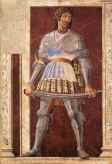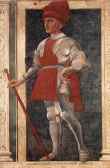Andrea del Castagno Biography
Andrea del Castagno (full name Andrea di Bartolo di Bargilla, also Andrea di Bartolomeo di Simone di Bargilla), one of the most influential 15th-century Italian Renaissance painters, was born c. 1421/23 in a village of Castagno, near Florence.
Due to Giorgio Vasari’s mistake in “Lives of the Painters, Sculptors and Architects”, where he vividly described the brutal murder of Domenico Veneziano by his friend, Andrea del Castagno, the name of the artist and his works were forgotten for centuries.
Little is known of Castagno's early life and training. His style shows the influence of Masaccio and Donatello. Except for a brief period in Venice, approximately in 1442, Andrea worked all his life in Florence. His first notable work, not preserved, fresco at the Palazzo del Podestà in Florence, which depicted the execution of the Medici's enemies, hanged by their heels.
The first well-known of Castagno's preserved works were fulfilled for the refectory of the monastery of Sant’ Apollonia (now there is museum of Andrea del Castagno in the monastery). Castagno worked on these monumental frescoes in 1445- 1450. The wall is visually divided into 2 parts, the lower part is the most famous of his frescoes, the Last Supper, the upper part contained three scenes from the Christ's Passion – Crucifixion in the center, Resurrection on the left, and Deposition on the right. The mixed chronology of the events shows the symbolic character of the painting.
The influence of Donatello is felt in Andrea's next work – decoration of the Villa Carducci-Pandolfini in Legnaia. Andrea worked on the decoration of a big loggia, rectangular gallery without one wall, c.1449-1451. One of the short walls of the gallery was decorated with figures of Adam and Eve, and Madonna with Child in a lunette over a door. The opposite wall had a Crucifixion. The long wall had frescoes, now known as Famous Men and Women – on the left there were the three political figures of Florence, Pippo Spano, Farinata degli Uberti, Niccolò Acciaiuoli, in the center three mythological women, the Camaean Sibyl, Queen Esther and Queen Tomyris; on the right three great Florentine scholars and poets Francesco Petrarch, Giovanni Boccaccio, and Dante Allighieri. Frescoes were placed inside painted niches, separated by pilasters. The frescoes of famous people were discovered in 1847; they were transferred to wooden panels and were exhibited first in Uffizi, then in Sant’Apolonnia, now again in Uffizi.
In 1451 Castagno worked with Domenico Veneziano at San Egidio. The influence of the later can be traced in the light tones that Castagno adopted for his fresco St Julian and the Redeemer. After 1451 he also carried out a series of frescoes for the Santissima Annunziata. His last known work is the portrait of Niccoló da Tolentino in Santa Maria del Fiore (1456).
The painter died of plague in 1457.
Bibliography
Horner M. Andrea del Castagno. Oxford. 1980.
Andrea Del Castagno: Complete Edition With a Critical Catalogue by Marita Horster, Cornell Univ Pr; 1980.
Monumental Painting of Italian Renaissance. by I. Smirnova. Moscow. 1987.
The Art of the Italian Renaissance. Architecture. Sculpture. Painting. Drawing. Könemann. 1995.
Painting of Europe. XIII-XX centuries. Encyclopedic Dictionary. Moscow. Iskusstvo. 1999.
Andrea Del Castagno and His Patrons by John R. Spencer. Duke Univ Pr, 1991.
- The Last Supper.

c.1447-49. Fresco. Sant'Apollonia, Florence, Italy. Read Note.
- Pippo Spano.

From the Cycle of Famous Men and Women. Detached fresco. 250 x 154 cm. Galleria degli Uffizi, Florence, Italy. Read Note.
- Farinata Degli Uberti.

c. 1448. From the Cycle of Famous Men and Women. Fresco transferred to wood. 250 x 154 cm. Galleria degli Uffizi, Florence, Italy. Read Note.